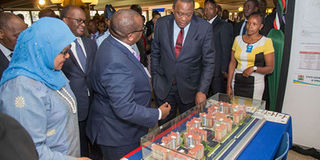The right to housing is a right to life

President Uhuru Kenyatta (second right) views a housing model at an exhibition stand moments before leading the world in marking World Habitat Day 2018 at United Nations Complex in Gigiri. The question of housing remains a promise and an unfulfilled commitment to many. PHOTO | COURTESY
What you need to know:
- The house is also a reservoir of many other invisible contents of life. It is here that we place our memories.
- The house gives us a compass, a bearing and a location from where to start. It also suggests where we go.
World Habitat Day is marked every first Monday of October.
This year’s celebrations were held on October 7. This is the day when we reaffirm our commitment to promote and protect human habitat.
While human habitat is a much larger place and space, we often think through it via one of its few components, namely housing.
There is no doubt that housing is a critical ingredient of human habitat. In Kenya, it is a matter of such dire crisis that a deficit of housing has made mockery of the provisions of Section 43(1)(b) of the Constitution, which guarantees the right to “accessible and adequate housing and reasonable standards of sanitation”.
The expectation, under international human rights law, therefore, is that Kenya should respect, protect and fulfil the right to housing.
It is here that the so-called ‘Big Four Agenda’ and the State’s commitment to deliver adequate housing become useful.
VITAL COMMODITY
The question of housing remains a promise and an unfulfilled commitment to many.
Even then, access to adequate housing is an indicator of the values and democratic commitment of a society.
Here, we mean not just the four corners and roof which constitute the physical house but rather the various social meanings of housing that are public on one hand but most often private.
Because the intervention of national government on the aegis of the Big Four has engaged housing as yet another commodity to the produced and supplied, let me use the words of French philosopher Gaston Bachelard in his famous book, The Poetics of Space, to explain what housing actually means and why its commodification and commercialisation negates the real meaning of the right to adequate housing.
Bachelard said, “Every corner in a house, every angle in a room, every inch of secluded space in which we like to hide, or withdraw into ourselves, is a symbol of solitude for the imagination; that is to say, it is the germ of a room or a house.”
The house is also a reservoir of many other invisible contents of life. It is here that we place our memories. Irrespective of the size of the house, people always place their artefacts and mental images there.
FREEDOM
But even more, it is here that we have the most commonplace for our intimate lives.
More so, in a world where we are largely labelled as anonymous and crowd, it is in the house that we get our safest corner of the world.
The house allows us to at least own or can make a claim of something. It is here that you possess the key and can lock yourself in with those you choose and shut out those who you do not require or desire. It is here that we enjoy the freedom of when to leave.
Most importantly, it is the house that gives meaning to the word “return”; it becomes some sort of origin, from where you come and go back.
Its relationship with our everyday life and mobility becomes almost automated; it’s a routine that does not tire.
We get comfortable in the house not only through these memories that we protect but more because it is the house that makes geography useful in our lives.
The house gives us a compass, a bearing and a location from where to start. It also suggests where we go.
PLANNING
Because it carries our dream, it’s in the house that we negotiate where to go and prospects for the future we want.
In examining the house where we live at any one moment, we attempt to imagine and create images of where we want to go. In other words, the future is made clear because we have a house.
But the house is not just a building that we put together. As Bachelard said, “One must live to build one’s house, and not build one’s house to live in.”
There is something inherently dignifying in one ‘building’ their house. We build not just by mortar and cement.
Rather, the first building is that of the people, when you have the freedom to choose to build your house either individually or through co-operation, when you can choose where to live and who your neighbour becomes.
COMMITMENT
Bachelard concludes: “If I was asked to name the chief benefit of the house, I would say the house shelters daydreaming, the house protects the dreamer, the house allows one to dream in peace.”
Let us rethink our idea of delivering housing. The national government can improve on connectivity between places, reduce the cost of housing financing and allow us to have truly independent and integrity bodies like the National Land Commission, then we would make useful strides towards realising the right to housing in Kenya.
As long as we treat it as any other skeletonised commodity and without a social life, the right to adequate housing will remain a mirage.
Dr Akoth is a board member of Pamoja Trust. [email protected]




